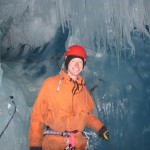
On Saturday, the field assistants Cheese and Roger laid on a recreational trip down our local crevasse. Crevasses open up as glaciers move, and are the result of brittle failure of the ice as it slips downslope. Crevasses are a significant hazard on any glacierised terrain, and can extend all the way down to the bottom of the glacier. They also trap surface water, and can divert surface streams to the base of the glacier. Surface streams aren’t, however, too much of a problem around Rothera at the moment!
The Show Crevasse

The glacier behind Rothera, which is part of the local travel area, has a number of crevasses. Each year, the field assistants mark out a safe route on the Ramp and on the traverse to Vals. The route is marked out with flags, and to avoid crevasses, you must stay within the flags at all times. There is, however, one friendly little crevasse that does not go down too deep, and for several years, people have been able to explore it (but only if accompanied by a field assistant).
The crevasse had only just been opened up by the recent melting of snow. The field assistants had to dig out the surface ‘bridge’ of snow, and then investigate it to see if it was still safe. On this trip, the ‘punters’ were Adam the Pilot, Jake and Dave the Saints (domestics), Jen the Doc, myself and Jayne the Meterologist.
The descent

To enter the crevasse, you must abseil downwards and backwards into the dark hole. Once down, there are static lines that you can clip in to, to ensure your safety. The crevasse is dim, but not dark; light penetrates through the snow bridge above. The walls and floor are solid ice; the floor is smooth and slick with frozen water ice. From the ceiling hang thousands of crystal clear icicles, which shatter if you touch them. Some of them are rounded and rotated, as the walls move due to deformation of the ice. The ice is blue, and if you look carefully, in some places you can see the compressed annual layers of snow.
The crevasse has a number of caverns that you can squeeze into. Some of them are a rather tight fit, and I got stuck when I tried to slide through a small gap, with my camera stuffed down my waterproof jacket! After a little flailing and much amusement (on the part of Roger and Cheese, mostly), I managed to unstick myself, remove my bulky camera, and fit through the gap.
To exit the crevasse, you had to jumar back up the rope, and we all quickly emerged, blinking in the sunlight, despite the dull low clouds. For a glaciologist, who normally maps these things from space, absolute heaven.


















